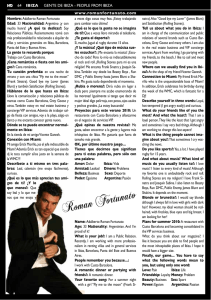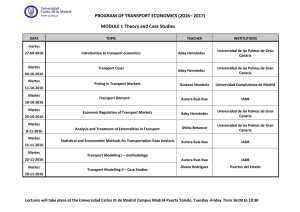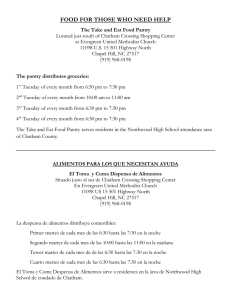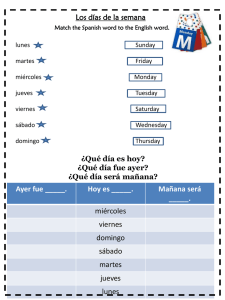the stone marten martes foina (erxleben, 1777)
Anuncio
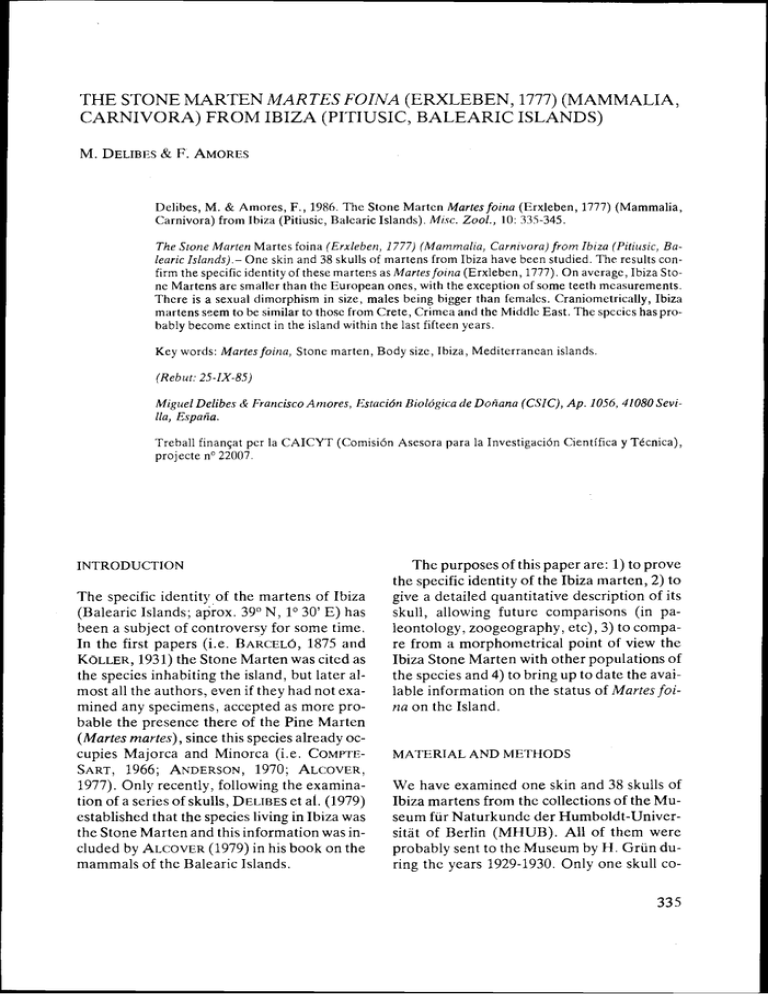
THE STONE MARTEN MARTES FOINA (ERXLEBEN, 1777) (MAMMALIA, CARNIVORA) FROM IBIZA (PITIUSIC, BALEARIC ISLANDS) Delibes, M. & Amores, F., 1986. The Stone Marten Martes foina (Erxleben, 1777) (Mammalia, Carnivora) from Ibiza (Pitiusic, Balearic Islands). Misc. Zool., 10: 335-345. The Stone Marten Martes foina (Erxleben, 1777) (Mammalia, Carnivora)from Ibiza (Pitiusic, Balearic Islands).- One skin and 38 skulls of martens from Ibiza have been studied. The results confirm the specific identity of these martecs as Martes foina (Erxleben, 1777). On average, Ibiza Stone Martens are smaller than the European ones, with the exception of some teeth measurements. There is a sexual dimorphism in size, males being bigger than females. Craniometrically, Ibiza martens sPem to be similar to those from Crete, Crimea and the Middle East. The species hasprobably become extinct in the island within the last fifteen years. Key words: Martes foina, Stone marten, Body size, Ibiza, Mediterranean islands. (Rebut: 25-IX-85) Miguel Delibes & Francisco Amores, Estación Biológica de Doñana (CSIC),Ap. 1056,41080 Sevilla, España. Treball financat per la CAICYT (Comisión Asesora para la Investigación Científica y Técnica), projecte no 22007. INTRODUCTION The specific identity of the martens of Ibiza (Balearic Islands; apiox. 39" N, 1" 30' E) has been a subject of controversy for some time. ~ , and In the first papers (Le. B A R C E L 1875 KOLLER,1931) the Stone Marten was cited as the species inhabiting the island, but later almost al1 the authors, even if they had not examined any specimens, accepted as more probable the presence there of the Pine Marten (Martes martes), since this species already occupies Majorca and Minorca (Le. COMPTESART, 1966; ANDERSON,1970; ALCOVER, 1977). Only recently, following the examination of a series of skulls, DELIBES et al. (1979) established that the species living in Ibiza was the Stone Marten and this information was included by ALCOVER (1979) in his book on the mammals of the Balearic Islands. The purposes of this paper are: 1) to prove the specific identity of the Ibiza rnarten, 2) to give a detailed quantitative description of its skull, allowing future comparisons (in paleontology, zoogeography, etc), 3) to compare from a morphometrical point of view the Ibiza Stone Marten with other populations of the species and 4) to bring up to date the available information on the status of Martes foina on the Island. MATERIAL AND METHODS We have examined one skin and 38 skulls of Ibiza martens from the collections of the Museum für Naturkunde der Humboldt-Universitat of Berlin (MHUB). Al1 of them were probably sent to the Museum by H . Grün during the years 1929-1930. Only one skull co- rresponds to a very young individual, still without its definitive dentition, and it has been eliminated from the analysis. Forty=five cranial measurements were taken with a caliper to the nearest tenth of a millimeter. Al1 of them are described in ANDERSON (1970), andl or shown in figure 1. Colours are cited following SMITHE (1975). RESULTS AND DISCUSSION 1. Specific determination The Stone and the Pine Marten are quite similar morphologically, but severa1 authors, from MILLER(1912) and CABRERA (1914) to ANDERSON (1970) and ALTUNA(1973), have looked for differences between the skulls of Fig. 1. Cranium and mandibule of an Ibiza Stone Marten showing the way measurements were taken. Cráneo y mandíbula de una garduña de Ibiza mosbando la forma en que han sido tomadas las medidas. both species. We use some of these differences to prove the specific identity of the Ibiza martens. 1.1. Shape of the postorbital region Morphological differences in this area are well known, but only ALTUNA(1973) gives a method for separating Martes foina from Martes martes in relation to this character. According to this author, the skulls of both species are separated in a graph in which the distance FED (fig. 2) between the line which joins the postorbital processes and the line which joins the borders of the postorbital constriction, would be placed in ordinates, and in abcyses an index, 1.3. Other criteria Following MILLER(1912), various authors recognize a differential character in the concave-convex shape (in Martes martes) or biconvex shape (in Martes foina) of the P, crown. Also, the antero-posterior length of the inner lobe of M' with respect to the lenght across the paracone-metacone of this tooth would be bigger in Martes martes. Both characteristics confirm that the Ibiza skulls are of Stone Martens. 2. Body measurements and coloration We have examined the skin no 42674 (MHUB) whose data in the label are: "San Juan, Ibiza, Pityusen; 4.3.1930; Ipa T., H. POC x 100 Grün S.; 380,305,55,40". If the last numbers Altuna's 1 = correspond to the body measurements (Head POP and body lenght, HBL; Tail lenght, TL; Hind foot lenght, FL; Ear lenght, EL), the speciArranged in such a graph, al1 of the Ibiza men would be young (small HBL), but with martens skulls studied belong to the area colong ears and tail. The data for FL must be rresponding to Martes foina (fig. 2). erroneous. KOLLER(1931) gives the following externa1measurements for a male of Ibi1.2. Distance between the foramina mentoza: HBL 510, TL 240, FL 80 and EL 30. They niana are quite similar to those of the Iberian speci1914, gives for two males of (1970), quoting JANOSSY mens (CABRERA, For ANDERSON Madrid: HBL 445-470, TL 230-223, FL 75-82, (1963), the distance between the anterior and EL 32-33), even if the first author remarks posterior mental foramina of Martes foina is that the tail is always shorter in the Ibiza Marfrom 2.0 to 3.4 mm, while in Martes martes tens. they are set farther apart (from 5.9 to 9.6 The skin no 42674 is Raw Umber on the (1973) dates back the criterion mm). ALTUNA legs, Burnt Umber on the tail, a mixture of toa paper of 1888by Winterfeld and confirms Clay and Antique Brown on the back and its validity, the distance being from 2.0 to 4.3 Clay on the sides and the belly. Underfur is mm in the Stone Marten and from 4.0 to 8.0 whitish, as is the throat patch. Thís skin is nomm in the Pine Marten. ticeably more reddish and lighter in colour The anterior and posterior mental foramithan those of Sierra Morena (SW Spain), na have fused into one (distance nil) in 10 which have the back Burnt Umber (col. Esta(27.5%) of the 36 left jaws we examined. In ción Biológica de Doñana, EBD, Sevilla, the other 26 this distance varies from 2.2 to Spain). On the other hand, it is similar to the 4.5 mm, with a meanx = 3.63 and a standard type of M. f. mediterranea (Barret-Hamilton, deviation S.D. = 0.558. If the total sample is 1898) deposited in the British Museum (Naconsidered, the statistical parameters are n = tural History) of London, but probably both 36, = 2.63, S.D. = 1.717 and a range from pelts are discoloured. In spite of this, KOLLER O to 4.5 mm. These results remain within the (1931) describes the Ibiza martens: "The corange of variation corresponding to Martes lour of the back is a light yellowish brown, foina. x Fig. 2. Relationship between the index of Altuna and the distance FED shown; Ibiza martens. Al1 of them are in the zone corresponding to Martes foina. Relación entre el índice de Altuna y la distancia FED mostrada en el dibujo; Gardurias de Ibiza. Todos ellos se encuentran en la zona correspondiente a Martes foina. L 60 72 66 78 1 ALTUNA'S less brown that in M. foina foina. Underfur is also lighter than that of the typical form". It could be that the Ibiza Martens were lighter in colour than the continental ones. This question remains unsolved. 3. Sexual dimorphism The genus Martes shows important sexual dimorphism: males are usually bigger than females (ANDERSON,1970). Unfortunately only one of the examined skulls, a female, has the sex noted in its label. To try sexing the re- O O O Europe o O O 0 O o T 3.5 o o o o O O O 0 o o 0 O O 0 O O 0 0 0 0 0 0 0 0 0 0 0 0 . . . . . . o . . * * . . . . 0 . . 0 . . Ibiza 0 . . . . . . . 4.5. . . . . 5:0 . 4.0 . . . . . . . . . . . . . . . A maining skulls we have relied on the method suggested by VAN BREEet al. (1970), based on the lenght of the largest diameter of tiie lower canine at the leve1 of the edge of the ename1 (LCL) . By comparing the distribution frequencies of this diameter in the Stone Martens of Ibiza and those of Central Europe (data of VAN BREEet al., 1970) (fig. 3), it is found that: a) As a rule, specimens of Ibiza have lower values than those of Central Europe and therefore, the useful limits for VAN BREEet al. (1970) are not directly aplicable to this mate- A A A O A A A A A A A A A A A A A A A A A A A A A A A A A A A A A A A ~CL(rnrn) Fig. 3. Distribution of the Stone Martens of Central Europe (BREEet al., 1970) and Ibiza according to their lower canine lengths: O Females; Males; A Indeterminate sex. Distribución de las gardunas de Europa Central ( B R E Eel al., 1970) e Ibiza según las longitudes de sus caninos inferiores: O Hembras; Machos; A Sexo indeterminado. rial; b) The bimodality of the measurements of the Ibiza skulls strongly suggests the existence of a noticeable sexual dimorphism in this population, even if the intermediate position of some dimensions makes it imposible to sex each specimen solely under this criterion. A graphical representation of the condylobasa1 lenght (CBL) against the largest diameter of the canine (fig. 4) shows not only the correlation between both dimensions (r = 0.762; p < 0.001), but also the trend of the points to place themselves into two groups, most likely corresponding to both sexes. Five individuals can be considered uncertain with regard to sex. Then, the measurements of the postorbital constriction are plotted against those of the zygomatic breadth, which constitutes the method used by ANDERSON (1970) to sex martens. Al1 the presumed males are well separated from the presumed females. Four of the uncertain cases are included with the females and one with the males (fig. 5). Thus, presumably, al1 the skulls can be sexed whenever it is possible to measure CBL, POC, ZB, and LCL, specially if the relative age is known. 4. Craniometry ,* ,' . / 1 0 l. .. The range, mean, standard deviation and size of the sample for each measurement, without regard to sex, are shown in table 1. Although the sex is only presumed, the same statistical parameters for some of the measurements of males and females are presented in table 2. The cranial capacity has also been measured, ranging from 19.59 to 24.80 cc formales (n = 9; X = 21.83) and from 15.99to 22.08 cc for females (n = 19; Z = 18.63). Considenng each sex as a separate sample, there is not a close relationship between the cranial capacity and the general size (Le. CBL) of the skull (correlation coefficient r = 0.07 formales and r = - 0.02 for females). dd? Fig. 4. Relationship between condylobasal length and lower canine length: A Female; Indeterminate sex. Relación entre la longitud condilobasal y la longitud del canino inferior: A Hembra; Sexo indeterminado. Fig. 5. Relationship between zygomatic breadth and postorbital constriction in the Stone Martens from Ibiza: O Presumed females in fig. 4; Female; A Presumed males in fig. 4; * Indeterminate sex in fig. 4. Relación entre la anchura cigomática y la anchura postorbital en las garduñas de Ibiza: O Presuntas hernbras en la fig. 4; Hembra, A Presuntos machos en la fig. 4; * sexo indeterminado en la fig. 4. i 19. A O - . 17 o o A • 18. U 2 A A * - 8 A A A O O "8 * 00 * A A A A O O 16. * O o 15. 43 45 47 49 ZB ímm) Table 1. Cranial and dental dimensions in mm of the Ibiza Stone Martens compared with those of Central Europe (data from ANDERSON, 1970): n. sample size; s.d. standard deviation; sign. statistical differences (Student t test); * * * p < 0.001; * * p < 0.01; * p < 0.05; NS: p > 0.05. For measurements, see figure 1 . Medidas craneales y dentales en m m de las garduñas de Ibiza y comparación con las de Europa Central (datos 1970): n. tamaño de la muestra; s.d. desviación típica; sign. significación estadística de las diferende ANDERSON, cias (test de la t de Student). Para las medidas, ver la figura 1. Ibiza Measurements Condylobasal lenght (CBL) Total length (TL) Basilar length (BL) Zygomatic breadth (ZB) Palatal length (PL) Rostral breadth a. canines (WC-C) Bimolar breadth (WP4-P4 Interorbital breadth (INB) Postorbital processes breadth (POP) Postorb. constriction breadth (POC) Mastoid breadth (MB) Cranial height (CH) Cranial box breadth (CB) Bicondylar breadth (BCB) Tympanic bulla length (LTB) Mandible length (ML) Mandible height (MH) Ramus depth between M,, (DM,,) Maxillary tooth row length (LC-M') Mandibular tooth row length (LC-M,) Incisor breadth (W13-13) Upper canine length (LCU) Upper canine breadth (WCU) Lower canine length (LCL) Lowerxanine breadth (WCL) Length first upper premolar (LP') Length first lower premolar (LP,) Length second upper premolar (LP2) Length second lower premolar (LP,) Length third upper premolar (LP3) Length third lover premolar (LP,) Length fourth upper premolar (LP4) Length fourth lower premolar (LP,) Length of protocone of P4(LP4pc) Breadth of protocone of P4(WP4pc) Breadth of blade of P4(BP4bl) Upper molar breadth (BM') Upper molar inner length (LM1i) Upper molar mid length (LM1m) Upper molar outer length (LM1o) Length first lower molar (LM,) Tngonid length of M, (LM,tr) Talonid breadth of M, (WM,tal) Length second lower molar (LM,) Breadth second lower molar (WM,) n range mean Europe s.d. mean sign. Tabla 2. Some selected measurements of sexed Ibiza Stone Martens: n. sample size; s.d. standard deviation. Parámetros estadísticos habituales de algunas medidas de las garduñas de Ibiza sexadas: n. tamaño de muestra; s.d. desviación típica. Presumed males Mcasurcmcnts n range mean Presumed females s.d. n range mean s.d. -- CBL ZB INB MB ML MH CB 13 13 13 13 13 13 12 77.5-82.0 45.6-49.1 19.3-21.2 35.6-37.4 51.0-54.0 22.3-25.1 35.5-36.5 80.2 47.3 20.2 36.9 52.7 23.8 35.9 5. Comparison with other populations Ibiza Stone Martens are significantly smaller than European ones in almost al1 the measurements considered (table l ) , even if probably more than 60% of the specimens in the Ibiza sample were females. The main exceptions correspond to the lengths of the lower carnassial (LM, and LM,tr), statistically larger in Ibiza, and the lenght of P4, which does not differ in both samples. Other measurements which do not show statistical differences correspond to very short distances or are Fig. 6. Range, mean, standard deviation and size of the sample for the condylobasa1 length and the zygomatic breadth of Martes foina from 11 geographic regions: CA. Central Asia; SI. Siberia; NB. Northern Burgos (Spain); PY. Pyrenees; SS. Southern Spain; MO. Mongolia; EU. Central Europe; IB. Ibiza; CR. Crimea; ME. Middle East; CC. Crete. Recorrido, media, desviación típica y tamaño de lp muestra para la longitud condilobasal y la anchura cigomática de Martes foina en 11zonas geográficas. 1.41 1.09 0.57 0.56 0.91 0.77 0.53 22 21 22 22 22 22 22 too difficult to be taken accurately. The CBL and the ZB of 11 populations of Stone Martens have been compared, including that of Ibiza (fig.'6). To do this both sexes have been pooled for each population. Geographic origin, subspecies (according to & MORRISSON-SCOTT, 1966) and ELLERMAN source of data of each sample are as follows (from East to West): 1.Mongolia (Martes foina intermedia), data in CHOTOLCHU et al. (1980); 2. Siberia (M. f. intermedia), STROGANOV (1962); 3.Caucasus (M. f. nehringi), HEPTNER et al. (1967); 4. Crimea (M. f. rosa- nowi), HEPTNER et al. (1967); 5. Middle East (M. f. syriaca), HARRISON(1968); 6. Crete (M. f. bunites), MILLER(1912) and ANDERSON (1970); 7. Central Europe s.a. (M. f. foi(1970); 8. Pyrenees (M. f. na), ANDERSON foina), VERICAD(1970); 9. Ibiza, this paper; 10. Northern Burgos, Spain (M. f. foina), this paper: skulls of the EBD collection; 11.Southern Spain (M. f. mediterranea), this paper: col. EBD. The standard deviation from the range (SNEDECOR & COCHRAN, 1967) for the sampies of Siberia and Crimea (ZB) was estimated. The upper limit of the range and the standard deviation of the CBL are unknown for the Crimea sample. Recently, CORBET(1978) has included the subspecies nehringi, rosanowi, syriaca and mediterranea in M. f. foina. CBL in Ibiza is statistically smaller than those of al1 the other populations, except the Middle East, Crete and Crimea. This occurs also with regard to ZB, although in this case the small sample from Crete only differs statistically from those of Ibiza and Crimea (fig. 7). Two groups are easily differentiated in figure 7: on one hand, the continental Eurosiberian populations and on the other the insular (Crete, Ibiza), extreme peninsular (Crimes) and Southernmost (Middle E&) populations. With minor exceptions, samples do not differ statistically within these groups. 6. Anomalies in the skull and the dentition ........ . .. ... .............. .<.o01 P.OS p<. 01 p<05 Fig. 7. Statistical comparison (Student t test) of the condylobasal length and the zygornatic breadth of Martes foina from 11 geographic r e g i 0 n s . l p < 0.001; <0 . 0 0 5 ; < ~ 0.01 ~ a p < 0.05. Comparación estadística mediante la t de Student de la longitud condilobasal y la anchura cigomática de Martes foina en 11 zonas geográficas. p < 0,001; < 0,005; < 0,ol; < 0,05. ap mp 342 , ap In a small isolated population, founder effect (MAYR,1963) and genetical drift can be manifest in the way of morphological anomalies. Thus, anomalous characteristics in the skull and teeth of the Ibiza Martens, have been looked for. The frequency with which the two mental foramina are fused into one in the Stone Martens of Ibiza (27.5% of the cases) has not been observed in continental populations of the species and it is the clearest symptom of genetical drift in this sample. Moreover, in one of the skulls a tympanic bulla is atrophied. Two skulls lack a P1, neither Pl is present in ten mandibles (31.3%), two others lack the left P, and other two the right P1. On the whole, 43.8% of the mandibles lack some P,. Two mandibles lack both M,. The lack of some of these teeth, specially P,, is not rare in continental Spanish and French Stone Martens (authors, unpublished). Seven skulls andlor mandibles (20%) show signs of old injuries in the lack of a tooth or group of teeth and in bone deformations. Possible caries appear in the MI of one skull. of cases i n j u r ~ could be the In trapping. ~ I 7. Habitat and current status of the species in Ibiza KOLLER(1931) gives information on the habitat of the species in the island: "Its way of life resembles that of the Pine Marten. It does not like buildings, and instead it prefers pine forests. It shares this habitat with the Genet as well as the boulders and rocky cliffs, where crevices and natural caves provide a great deal of protection". That confirms that in allopatry with the Pine Marten, the Stone Marten is a generalist in relation to its habitat (DELIBES,1983). Judging by the number of specimens collected by Grün in a relatively short period of time, the Stone Marten must have been common in Ibiza around 1930. Around that time, the species probably suffered strong human predation pressure because of its pelt value (the collector sent only skulls (with one exc e p t i ~ n )to Berlin, contrasting with the 32 skins of Genets (Genetta genetta) from the same island and period deposited in the & MHUB). Thirty five years later, VERICAD BALCELLS (1965) considered that this Marten lived in very small numbers on the island, imputing this to human hunting. Also, COMPTESART(1966) notes its rarity in the sixties. Ten years ago, according to some hunters, one marten was killed every two or three years (ALCOVER,1979). Onedf the authors identified one dropping collected in Ibiza in 1977 as belonging to Martes foina. ALCOVER(1983) considers that the species has disappeared from the island at some undetermined date of the last decades. It is very likely that the only insular population of Stone Martens in the Western Mediterranean no longer exists. 8. A comment on the taxonomy The small size, the teeth proportions and the geographical isolation of the Ibiza Martens could justify the recognition of a new subspecies. However, our very simple analysis does not detect morphological differences between the martens of Ibiza and those of Crete, Crimea and the Middle East. Probably, morphological similarity of these populations is the result of parallel evolutionary changes as a consequence of the insularity conditions. MAYR (1969) writes on this topic: "In the absence of diagnostic differences there is not legitimate excuse for dividing a single polytopic subspecies into severa1 subspecies merely on the basis of locality". Therefore, before more rigorous analysis are done on the insular and Southernmost populations of the species, it is preferable to name the Ibiza martens simply as Martes foina. CONCLUSIONS Certainly, the martens inhabiting the island of Ibiza were Martes foina. This contrasts with the fact that neighbouring islands of Majorca and Minorca are inhabited by Martes martes. Not enough material was examined to be able to discuss the colour pattern of the Ibiza martens, but probably they were lighter and more reddish than the continental ones. The Ibiza Stone Martens are dimorphic in size and their skulls can be sexed if the following measurements are known: CBL, ZB, POC and LCL. Males are bigger than females in al1 of :he considered dimensions. Almost al1 of the measurements of the Ibiza Martens are statistically smaller than those of the Centroeuropean ones. Only the carnassials are of similar size or bigger in Ibiza. CBL and ZB of eleven compared populations can be classified into two groups: the first one includes the continental Euroasiatic populations, whose measurements are bigger on average, and the second one the insular (Crete, Ibiza, even Crimea) and Southernmost (Middle East) populations. The only presumed evidence of genetical drift in the Ibiza Stone Martens is reflected by the high frequency with which the two mental foramina are fused into one. Old injuries are also frequent. Almost 50% of the mandibles lack one or both P,. Stone Marten occupied the pine forests and the rocky areas of the island, avoiding the human environments. Probably the species disappeared from Ibiza at some undetermined date in the last ten years. The presence of Martes foina in Ibiza and Martes martes in Majorca and Minorca, together with the morphoevolutive trends of the three populations, raises interesting ecological and zoogeographical questions that would deserve further studies. ACKNOWLEDGEMENTS A preliminary analysis of the material was madein the Museum für Naturkunde der Humboldt-Universitat zu Berlin (German Democratic Republic, DDR). Later, specimens were borrowed by us from this Museum. Our sincere thanks go to Dr. R. Angermann, who arranged the loan and gave us her aid and generous hospitality. Dr. J. Castroviejo and the Spanish Dirección General de Relaciones Culturales made possible the trip to the DDR, where we also received the aid of Dr. J. Calderón and Dr. F. Hiraldo. J. Peña made one of the drawings. Dr. J. A. Alcover and M. Aymench read the manuscnpt and L. E. Fisher and N. Bustamante revised the English version. Special thanks to E. Collado, who made the drawings, read the manuscript and helped us with the computer. Dr. G. B. Corbet improved a first draft of the paper. RESUMEN La Garduña Martes foina (Erxleben, 1777) (Mammalia, Carnivora) de la Isla de Ibiza (Pitiusas, Baleares).- El estudio de una piel y 38 cráneos de martas procedentes de Ibiza confirma que la especie que existió en la isla fue la garduña o foina Martes foina. En promedio, las gardufias de Ibiza son de menor tamaño que las europeas, exceptuando algunas medidas dentarias. Los machos son algo mayores que las hembras. Craneométricamente las garduñas de Ibiza parecen similares a las de Creta, Cnmea y Oriente Medio. Probablemente la especie ha desaparecido de la isla en los últimos 15 años. REFERENCES ALCOVER, J.A., 1977. The long-tailed Field Mouse or Wood Mouse Apodemus sylvaticus (Linné, 1758) from the island of Ibiza, Pityusics. Süugetierk. Mitteil., 25: 204-213. - 1979. Els mamífers de les Balears. Ed. Moll Ciutat de Mallorca. - 1983. Contribució al coneixement dels mamífers de les Balears i Pitiüses: Camivora, Rodentia. Ph.D. Thesis, Universidad de Barcelona. ALTUNA,J., 1973. Distinción craneal entre la Marta (Martes martes) y la Foina (M. foina) (Mammalia). Munibe, 25: 33-38. ANDERSON, E., 1970. Quaternary evolution of the genus Martes (Camivora, Mustelidae). Acta Zoologica Fennica, 130: 1-132 B A R C E LF., ~ , 1875. Apuntes para la fauna balear. Catálogo metódico de los mamíferos observados en las Islas Baleares. An. Soc. Esp. Hist. Nat., 5: 5368. P.J.A. VAN & UTRECHT BREE,P. J.H. VAN,MENSCH, W.L. VAN,1970. Sur le dimorphisme sexuel des canines chez la fouine, Martes foina (Erxleben, 1777). Mammalia, 34: 676-682. CABRERA,A,, 1914. Fauna Ibérica. Mamíferos. Museo Nac. Ciencias Naturales. Madrid. CHOTOLCHU, N., STUBBE,M. & DAWAA,N'., 1980. Der Steinmarder Martes foina (Erxleben, 1777) in der Mongolei. Acta theriologica, 25: 105-114. COMPTE-SART, A., 1966. Resultados de una expedición zoológica a las islas Pitiusas. 1. Vertebrados. Bol. R. Soc. Española Hist. Nat. (Biol.), 64: 1546. CORBET,G.B ., 1978. The mammals of the Paleartic Region. A taxonomic review. Bntish Museum (Natural History). London. DELIBES,M., 1983. Interspecific competition and the habitat of the Stone Marten Martes foina Erxleben, 1777) in Europe. Acta Zoologica Fennica, 174: 229-231. DELIBES,M., AMORES,F., HIRALDO,F. & CALDER ~ NJ.,, 1979. Martes foina (Erxleben, 1777) y no Martes martes (Linnaeus, 1758) en la isla de Ibiza (Pitiusas, Baleares). Doñana Acta vert., 6: 239240. ELLERMAN, J.R. & MORRISON-SCOIT, T.C.S., 1966. Checklist of Palaearctic and Indian Mammals. British Museum (Natural History). London. HARRISON,D.L., 1968. The Mammals of Arabia. Vol. 2. Ernest Benn Limited. London. H E ~ E RV.G., , NAUMOV,N.P., JORGENSON P.B., SLUDSKI,A.A., CIRCOVA,A.F. & BANNIKOV, A.G., 1967. Die Süugetiere der Sowjetunion. Band 11: Seekühe und Raubtiere. Gustav Fischer Verlag, Jena 1974. JANOSSY,D . , 1963. Letzinterglaziale VertebratenFauna aus der Kilmán Lambrecht-Hohle (BükkGebirge, Nordost-Ungarn). 1. Acta 2001.Acad. Sci. Hung., 9: 293-331. KOLLER,O., 1931. Die Saugetiere der Pityusen (Spanien). Sitzb. Akad. Wiss. Wien, Math. Naturwiss. Kl. Abt., 1, 140: 57-65. MAYR,E., 1963. Animal species and evolution. Harvard Univ. Press. Cambridge. Mass. - 1969. Principles of Systematics Zoology. McGrawHill. New York. MILLER,G.S., 1912. Catalogue of the Mammals of Western Europe. British Museum (Natural History). London. SMITHE,F.B., 1975. Naturalist's color guide. The Amencan Museum Natural History. New York. SNEDECOR, G.W. & COCHRAN,W.G., 1967. Statistical methodi. Iowa State Univ. Press., 6th ed. Ames, Iowa. STROGANOV, S.U., 1962. Carnivoroui mammal of Si- beria. Israel Program Scientific Translations, Jerusalem 1969. VERICAD,J.R., 1970. Estudio faunístico y biológico de los mamíferos del Pirineo. Publ. C. Pir. Biol. Exp., 4: 7-232. E., 1965. Fauna mastoVERICAD, J.R. & BALCELLS, zoológica de las Pitiusas. Bol. R. Soc. Española Hist. Nat. (Biol.), 63: 233-264.
